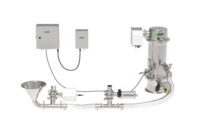The nation’s network of refrigerated and frozen distribution centers forms a logistical supply chain that is vital to today’s food safety. Yet, because of the high operational costs of freezing or cooling pallets of product within confined areas, every square inch of storage and every movement of product must be efficient. A challenge occurs, however, when frozen storage must be expanded across an irregular landscape that makes traditional, space-efficient, rectangular warehousing impossible.
To continue the growth of its distribution centers in the national logistics supply chain, Zero Mountain Inc. expanded its frozen storage and cooler capacity at its Fort Smith, Ark., headquarters facility. As a premium cold storage warehousing services provider to the food industry nationwide, Zero Mountain freezes, stores and ships an estimated 2 billion pounds of frozen food and meat annually for numerous Fortune 500 companies.
“We needed to expand our warehouse 100,000 square feet between two existing buildings,” says Joe Rumsey, president and CEO. “But, the landscape didn’t allow for a traditional rectangular-shaped warehouse, so one side was built at a sloping angle. Still, because of the operational cost of frozen and cooler storage, the design had to maximize storage density, capacity, efficiency and durability.”
Looking to achieve these goals, Rumsey turned to Cisco-Eagle, a materials handling, automation and storage systems integrator based in Jonesboro, Ark., and Steel King Industries, a storage system and pallet rack manufacturer headquartered in Stevens Point, Wis.
For freezer storage, the companies chose drive-in rack for its high-density storage capacity that requires fewer aisles and provides better cube utilization than selective rack. Drive-in rack enables storing up to 75% more pallets than selective racking, and is ideal for high-traffic and cooler/freezer installations.
To maximize efficient freezer storage design with the warehouse’s untraditional shape, the companies varied racking depth from 2-9 pallets deep and varied pallet opening heights, including some for 100-inch-high pallets for retail and some for 2,000-pound double-stacked pallets for export.
The result – an area of approximately 71,000 square feet that holds over 8,000 pallet positions, plus almost 300 pallet positions for blast cells, which are enclosed areas where product is flash frozen at -30°F for frozen storage.
The drive-in rack used required exceptional strength to support up to 4,000-pound pallet loads of frozen poultry and the weight of HVAC equipment for six rack-supported blast cells.
With drive-in rack, forklifts drive directly into the rack to allow storage of two or more pallets deep. Because forklifts drive directly into the rack, they tend to take more abuse than other rack structures. Rumsey was concerned that the industry’s typical, light-gauge, roll-formed rack would be prone to forklift damage and costly replacement.
As a solution, Cisco-Eagle recommended Steel King’s SK3000 drive-in rack, a rugged bolted rack with structural channel columns.
Compared to typical racking, the pallet rack constructed of hot-rolled structural channel column with full horizontal and diagonal bracing offers greater frame strength, durability and cross-sectional area. All Grade-5 hardware provides greater shear strength, and a heavy 7-gauge wrap-around connector plate ensures a square and plumb installation with a tighter connection and greater moment resistance.
“For the application, the SK3000 drive-in rack provides the most pallet positions per cubic foot with the highest per pallet and overall capacity,” says Amanda Miller, a Cisco-Eagle engineer on the project. “[A2-inch vertical rack adjustability also helped to optimize efficient storage for a range of pallet sizes]. Since it is structural, not roll formed, it offers a lot more rigidity and is able to better withstand any potential forklift impact.”
For strength, the load rails are constructed of durable structural angle steel, and feature a flared entry design that eases bay access and minimizes potential forklift impact. Space-saver low-profile arms increase clearance and decrease possible product damage.
Welded rail stops also improve safety by preventing loads from being pushed off the racks. To further increase rack clearance and reduce forklift impact with the rack, Zero Mountain selected an offset leg design option.
“The structural drive-in rack provides us with the strength, capacity and durability we need to withstand decades of use, where forklift impact is expected,” says Rumsey.
For almost 600 pallet positions of additional cooler storage in a smaller room in a dock area, the companies also chose a two-deep pushback rack arrangement around the perimeter of the room. A bolted tubular SK2500 pallet rack, made of high-strength (55,000 psi minimum) steel, offers up to 44 times more resistance to torsional fork truck impacts than open-back roll-formed columns.
Pushback pallet rack offers up to 90% more product storage than selective rack systems and up to 400% more selectivity than drive-in racks. Unlike static, single-pallet-deep selective racks, a dynamic pushback rack system allows pallets to be stored 2-5 deep while providing easy access to a variety of different SKUs.
With pushback rack, pallets are stored behind each other in a series of nested carts, and are loaded from the same side of the system, eliminating separate aisles for each function. Composed of a stable rack along with a series of inclined carts and rails, when one pallet is pulled, the one behind it rolls forward.
“The pushback rack gave us quick loading and unloading with good storage density in a dock area where most people do not usually have storage capacity,” adds Rumsey. “Together, with our drive-in rack, our warehouse expansion has helped to maximize our capacity and materials handling efficiency.”



